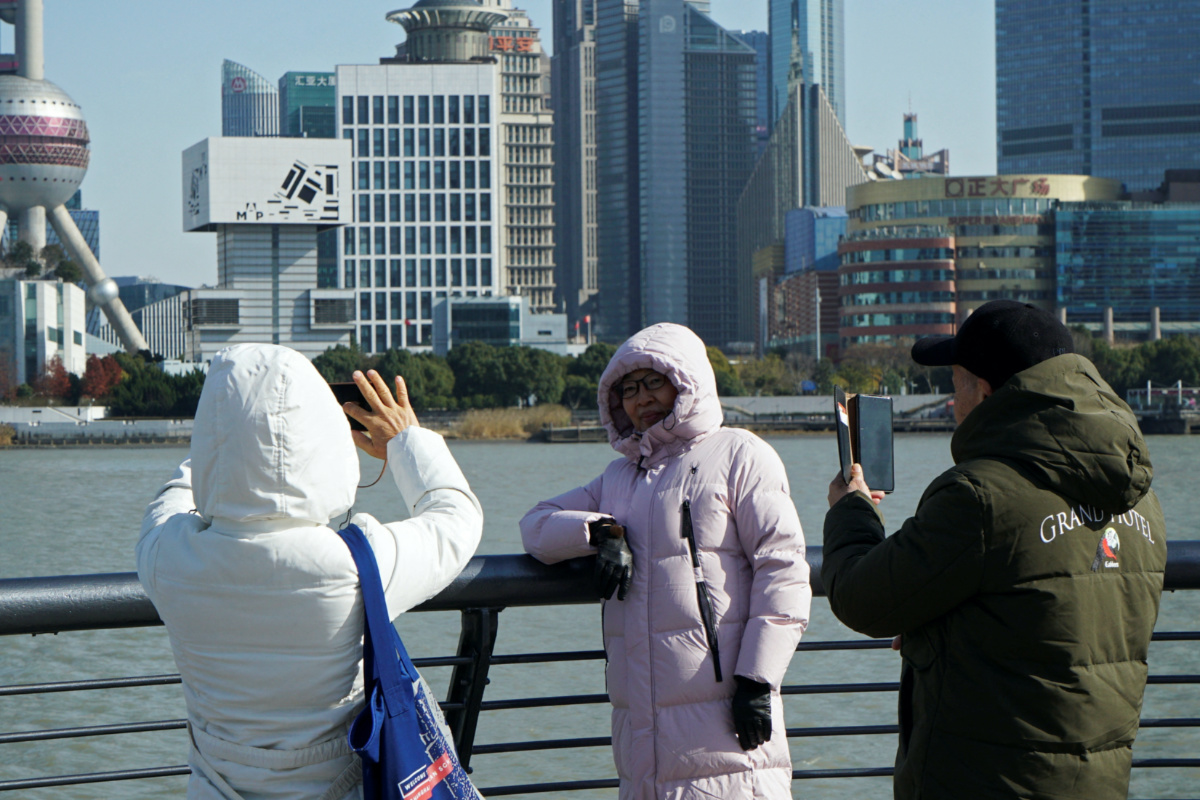Shanghai, China
Reuters
China’s financial hub Shanghai was set to record its chilliest period in December in four decades, spurring authorities to issue warnings for low temperatures and wind, while northern cities battled icy conditions forecast to ease only next week.
The city’s lowest temperatures on Thursday will be minus four to minus six degrees Celsius in Shanghai’s suburbs, and temperatures will remain below zero all day throughout the city, the Shanghai Meteorological Bureau said in a post on its Weibo social media account.

People wearing down jackets take pictures on the Bund on a cold winter day in Shanghai, China, on 21st December, 2023. PICTURE: Reuters/Nicoco Chan
Wang Kaiyun, 59, a cleaner in downtown Shanghai who commutes from the city’s suburbs on an electric scooter, said the temperature was minus five degrees on her one-hour ride in on Thursday.
“Even though I was wearing gloves, I quickly lost feeling in my hands and they are still painful now,” Wang said.
While the city’s temperatures remain far warmer than those in northern China, where many provinces have recorded historically low temperatures in recent weeks, the run of cold weather was unusual for Shanghai.
The city’s weather bureau said it expects the minimum temperature at one downtown reading station to remain below zero for five straight days until Dec. 25, a run of cold in the month of December that hasn’t occurred in 40 years.
“This year is not normal,” said a 68-year-old Shanghai resident surnamed Li. “This year is super cold and it was not this cold last year.”
The unusually frigid weather ushered in by a powerful wave of cold air from Siberia has spread across China since the middle of last week, with many northern provinces rewriting December records as the mercury sank as low as minus 30 degrees in some cities.
“We obviously see the influence of climate change on hot extremes, be they droughts, wildfires and heat waves,” said Benjamin P Horton, director of Earth Observatory of Singapore.
“But there’s so much instability in the atmosphere that you also see cold snaps where you get extreme cold temperatures, where polar temperatures migrate down in towards the mid-latitudes, causing unprecedented lows in temperature.”
“Narratives of suffering”
While the snowfall was modest compared to deep snowdrifts and blizzards seen in North America and Europe, the bitter cold, ice and gusty conditions in China have disrupted road, rail and air transportation, sharply increased demand for heating, and even hampered rescue efforts in the northwest where an earthquake destroyed over 200,000 homes.
On 13th December, as the cold wave swept into northern China, Yuanqu, a small county in northern Shanxi province, suddenly found itself without electricity. The rare power outage persisted for the next three days as its grid operator raced to de-ice transmission lines.
We rely on our readers to fund Sight's work - become a financial supporter today!
For more information, head to our Subscriber's page.
Residents without power also went without heating, as well as hot food and even mobile phone signal, according to Chinese media.
In Lvliang, a city of three million people also in Shanxi, firefighters had to put out a fire in a building even as their protective helmets and jackets quickly became encased in ice in minus 18 degrees conditions, state media reported on Thursday.
The cold snap has also threatened to freeze China’s busy online food delivery sector. On social media, some people have expressed their reluctance to order takeout in the extreme cold due to worries for the safety of delivery drivers.
Their concerns prompted the official Workers’ Daily on Thursday to urge people “not to dwell on narratives of suffering”, but instead, think of the potential loss of income for delivery drivers.
Across China, prices of vegetables have also risen due to the impact of the cold weather. The commerce ministry on Thursday said it would take measures to safeguard a stable supply of daily necessities.
The prolonged sub-freezing conditions across China are expected to ease from Friday, with temperatures rising back to historical averages next week, according to national forecasters.






